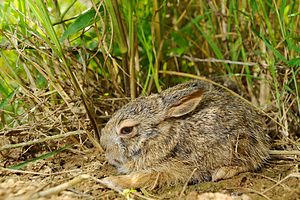Burmese hare
| Burmese hare | ||||||||||||
|---|---|---|---|---|---|---|---|---|---|---|---|---|

Burmese hare ( Lepus peguensis ), young animal |
||||||||||||
| Systematics | ||||||||||||
|
||||||||||||
| Scientific name | ||||||||||||
| Lepus peguensis | ||||||||||||
| Blyth , 1855 |
The Burmese hare ( Lepus peguensis ) is a species of mammal belonging to the genus of the real hare within the lagoon group . Its distribution area extends from Myanmar over large areas of the Southeast Asian peninsula to its easternmost coast in Vietnam .
features
The height of the Burmese hare is between 36 and 50 centimeters with a weight of 2 to 2.5 kilograms; he is one of the smaller rabbit species. The back is red-gray with black interspersed, the abdomen is gray and the tail is black on top. The belly side is white, the relatively large ears have a black tip. The feet of the animals in Myanmar are white, whereas those in Thailand are more reddish yellow.
distribution
The Burmese hare is common in a large area in Southeast Asia. It stretches from central and southern Myanmar from the Chindwin and Saluen riverbeds through Thailand , Cambodia and southern Laos to southern Vietnam . Other occurrences are probably in northern Laos, but have not been proven beyond doubt.
The hare prefers open forests and shrubby areas in the lowlands with tall grass and bushes, often along rivers that are seasonally flooded. It also occurs in extensively used rain- and flood-irrigated rice fields , but avoids intensively farmed agricultural areas. According to Chapman & Flux 1990, it lives mainly in dry, also wooded areas and regionally on sandy areas along the coast.
The altitude distribution is usually given as a maximum of 1,200 meters, due to the lack of typical habitats at higher altitudes such as the Nakai Plateau in Laos or the Thung Yai Naresuan in Thailand, this figure is considered too high.
Way of life
The Burmese hare is crepuscular and nocturnal. It mainly eats at night and feeds mainly on grass, bark and twigs.
Little data is available on reproduction. The hare probably litters several times a year with one to seven, on average three to four, young animals per litter. The gestation period is 35 to 40 days. The estimated lifespan of the hares is around six years.
Systematics
The Burmese hare is assigned to the real hare (genus Lepus ) as an independent species . Originally, the Hainan hare ( Lepus hainanus ), which is endemic to Hainan and is now regarded as a separate species, was also considered a subspecies of the Burmese hare. There is a close relationship with the black-necked hare ( L. nigicollis ), which was confirmed, among other things, by examining tooth features. It could be demonstrated that these two species are very closely related, but that both represent separate species including the subspecies under consideration. There is a greater distance to the Tibetan woolly hare ( L. oiostolus ) and the Chinese hare ( L. sinensis ), whose distribution areas connect north to those of the black-naped hare and the Burmese hare.
Today two subspecies are distinguished, the nominate form Lepus peguensis peguensis and L. p. vassali , Chapman & Flux 1990 also describe the subspecies L. p. siamensis .
A closer relationship exists with the black-necked hare ( L. nigricollis ) and Chapman & Flux 1990 raise the option that the Burmese hare is only a subspecies of the same.
Hazard and protection
The species is classified by the International Union for Conservation of Nature and Natural Resources (IUCN) as not endangered (least concern) due to the population size and the large distribution area. Mainly due to the conversion of forest areas into shrubby habitats, an increase in the population in the distribution area is assumed, although it is heavily hunted.
A regional intensification of agriculture as well as regular fires in Laos and Vietnam in the dry season pose a threat to the species.
supporting documents
- ↑ a b c d e Joseph A. Chapman, John EC Flux (Ed.): Rabbits, Hares and Pikas. Status Survey and Conservation Action Plan. (PDF; 11.3 MB) International Union for Conservation of Nature and Natural Resources (IUCN), Gland 1990. ISBN 2-8317-0019-1 .
- ↑ a b c d e f g h i Lepus peguensis in the endangered Red List species the IUCN 2011. Posted by: JW Duckworth, R. Steinmetz, A. Pattanavibool, 2008. Accessed January 28, 2012 Design.
- ↑ a b F. Suchentrunk: Phylogenetic relationships between Indian and Burmese hares (Lepus nigricollis and L. peguensis) inferred from epigenetic dental characters. ( Memento of the original from November 26, 2015 in the Internet Archive ) Info: The archive link was automatically inserted and not yet checked. Please check the original and archive link according to the instructions and then remove this notice. Mammalian Biology 69, 2004; Pp. 28-45.
literature
- Joseph A. Chapman, John EC Flux (Eds.): Rabbits, Hares and Pikas. Status Survey and Conservation Action Plan. (PDF; 11.3 MB) International Union for Conservation of Nature and Natural Resources (IUCN), Gland 1990. ISBN 2-8317-0019-1 .
Web links
- Lepus peguensis in the endangered Red List species the IUCN 2011. Posted by: JW Duckworth, R. Steinmetz, A. Pattanavibool, 2008. Accessed January 28, 2012 Design.
